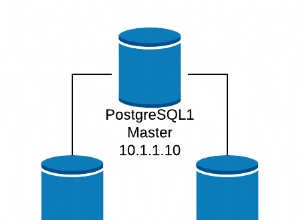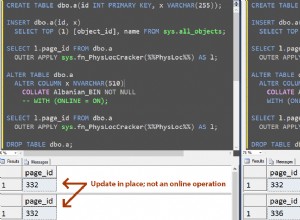मेरा मुख्य डीबीएमएस टेराडाटा है, लेकिन यह ओरेकल में भी काम करेगा।
WITH all_meas AS
( -- get a distinct list of all from/to points
SELECT road_id, from_meas AS meas
FROM road_events
UNION
SELECT road_id, to_meas
FROM road_events
)
-- select * from all_meas order by 1,2
, all_ranges AS
( -- create from/to ranges
SELECT road_id, meas AS from_meas
,Lead(meas)
Over (PARTITION BY road_id
ORDER BY meas) AS to_meas
FROM all_meas
)
-- SELECT * from all_ranges order by 1,2
, all_event_ranges AS
( -- now match the ranges to the event ranges
SELECT
ar.*
,re.event_id
,re.year
,re.total_road_length
,ar.to_meas - ar.from_meas AS event_length
-- used to filter the latest event as multiple events might cover the same range
,Row_Number()
Over (PARTITION BY ar.road_id, ar.from_meas
ORDER BY year DESC) AS rn
FROM all_ranges ar
JOIN road_events re
ON ar.road_id = re.road_id
AND ar.from_meas < re.to_meas
AND ar.to_meas > re.from_meas
WHERE ar.to_meas IS NOT NULL
)
SELECT event_id, road_id, year, total_road_length, Sum(event_length)
FROM all_event_ranges
WHERE rn = 1 -- latest year only
GROUP BY event_id, road_id, year, total_road_length
ORDER BY road_id, year DESC;
अगर आपको वास्तविक कवर किए गए from/to_meas . को वापस करने की आवश्यकता है (जैसा कि संपादित करने से पहले आपके प्रश्न में), यह अधिक जटिल हो सकता है। पहला भाग वही है, लेकिन एकत्रीकरण के बिना क्वेरी एक ही event_id के साथ आसन्न पंक्तियों को वापस कर सकती है (उदाहरण के लिए ईवेंट 3:0-1 और 1-25):
SELECT * FROM all_event_ranges
WHERE rn = 1
ORDER BY road_id, from_meas;
यदि आप आसन्न पंक्तियों को मर्ज करना चाहते हैं तो आपको दो और चरणों की आवश्यकता है (एक मानक दृष्टिकोण का उपयोग करके, समूह की पहली पंक्ति को ध्वजांकित करें और समूह संख्या की गणना करें):
WITH all_meas AS
(
SELECT road_id, from_meas AS meas
FROM road_events
UNION
SELECT road_id, to_meas
FROM road_events
)
-- select * from all_meas order by 1,2
, all_ranges AS
(
SELECT road_id, meas AS from_meas
,Lead(meas)
Over (PARTITION BY road_id
ORDER BY meas) AS to_meas
FROM all_meas
)
-- SELECT * from all_ranges order by 1,2
, all_event_ranges AS
(
SELECT
ar.*
,re.event_id
,re.year
,re.total_road_length
,ar.to_meas - ar.from_meas AS event_length
,Row_Number()
Over (PARTITION BY ar.road_id, ar.from_meas
ORDER BY year DESC) AS rn
FROM all_ranges ar
JOIN road_events re
ON ar.road_id = re.road_id
AND ar.from_meas < re.to_meas
AND ar.to_meas > re.from_meas
WHERE ar.to_meas IS NOT NULL
)
-- SELECT * FROM all_event_ranges WHERE rn = 1 ORDER BY road_id, from_meas
, adjacent_events AS
( -- assign 1 to the 1st row of an event
SELECT t.*
,CASE WHEN Lag(event_id)
Over(PARTITION BY road_id
ORDER BY from_meas) = event_id
THEN 0
ELSE 1
END AS flag
FROM all_event_ranges t
WHERE rn = 1
)
-- SELECT * FROM adjacent_events ORDER BY road_id, from_meas
, grouped_events AS
( -- assign a groupnumber to adjacent rows using a Cumulative Sum over 0/1
SELECT t.*
,Sum(flag)
Over (PARTITION BY road_id
ORDER BY from_meas
ROWS Unbounded Preceding) AS grp
FROM adjacent_events t
)
-- SELECT * FROM grouped_events ORDER BY road_id, from_meas
SELECT event_id, road_id, year, Min(from_meas), Max(to_meas), total_road_length, Sum(event_length)
FROM grouped_events
GROUP BY event_id, road_id, grp, year, total_road_length
ORDER BY 2, Min(from_meas);
संपादित करें:
ठीक है, मुझे अभी एक ब्लॉग मिला है प्राथमिकता के साथ ओवरलैपिंग रेंज कुछ सरलीकृत Oracle सिंटैक्स के साथ बिल्कुल वैसा ही करना। वास्तव में मैंने अपनी क्वेरी को टेराडाटा में कुछ अन्य सरलीकृत वाक्यविन्यास से मानक/ओरेकल एसक्यूएल :-)
में अनुवादित किया है



